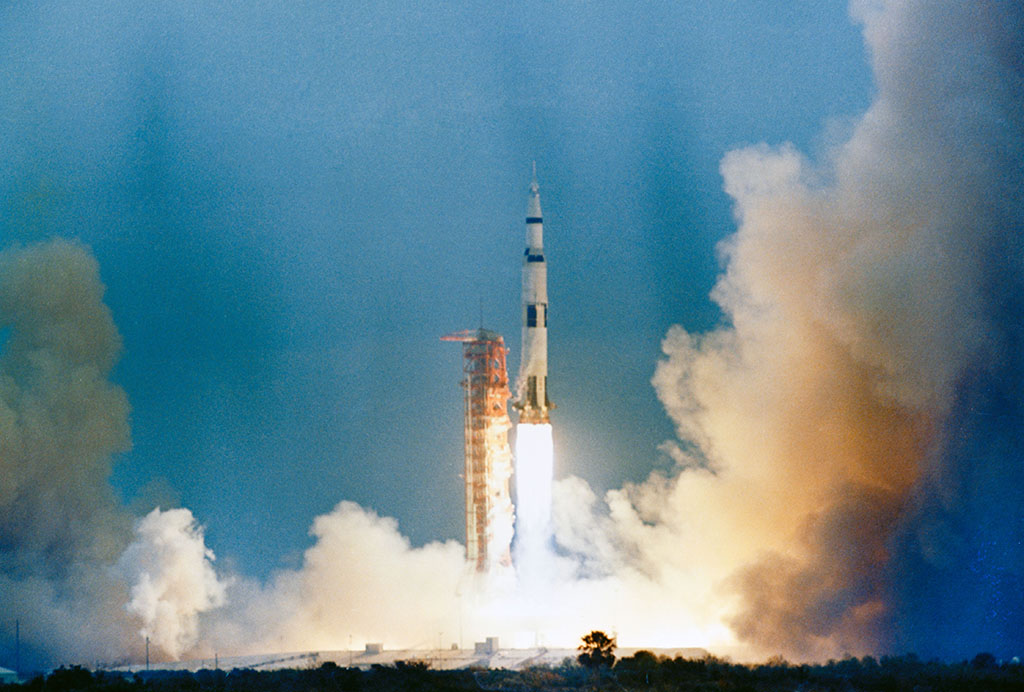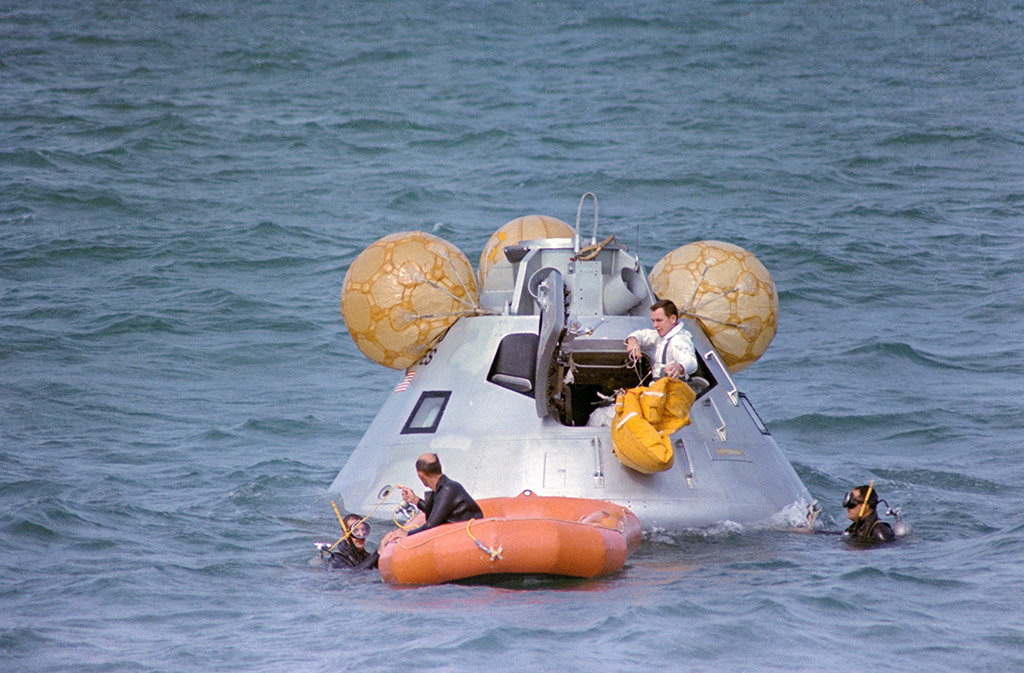During launch the LM was stowed in a conical adapter between the Saturn V’s third stage and the Command and Service Module (CSM). Once in orbit, the adapter split into four peals and was jettisoned. The astronauts turned the CSM around so the docking probe on Gumdrop faced the docking hatch on Spider. They docked with Spider three hours after liftoff.
After the crew verified the docking latches were secure, they maneuvered the combined CSM/LM away from the Saturn upper stage. Following a separation maneuver to make sure the spacecraft was well clear of the stage Mission Controllers fired the stage’s engine for just over a minute. They allowed the stage to coast for another orbit to give the engine a chance to cool then ordered a third firing. This time the engine burned for 242 seconds, long enough to take the stage out of Earth orbit. These engine tests allowed engineers on the ground to collect additional data on the performance of the Saturn’s third stage.
McDivitt, Scott and Schweickart spent the remainder of their first day in space evaluating the spacecraft. They also fired the Service Propulsion System (SPS) engine to raise their orbit slightly.

Apollo 9 launched from NASA’s Kennedy Space Center Image Credit: NASA
Activities on their second day in space included further systems checks and tests of the maneuverability of the CSM/LM combination. The crew fired the SPS engine three more times to raise their orbit to 275 by 112 nautical miles.
On mission day three, Schweickart boarded Spider. McDivitt joined him an hour later and they deployed the landing gear. (Even though this was an Earth orbital test, Spider had the landing gear that would be used for lunar landings.) McDivitt reported to Mission Control that Schweickart had been sick twice.
Schweickart performed an extravehicular activity (EVA) on mission day four with the Portable Life Support System (PLSS), a backpack that would allow astronauts to explore the Moon for up to seven hours at a time. The plans for the EVA were ambitious: tethered by a nylon rope, Schweickart was supposed to make his way from the LM “porch” to the open hatch on Gumdrop and back. This would simulate an emergency crew rescue if for some reason a returning LM could not dock with a CM.
Mission Control didn’t want to risk having Schweickart vomit inside his helmet, so they revised the planned EVA to eliminate the spacecraft to spacecraft transfer and minimized the amount of moving around he had to do. Shortening the EVA also gave the crew more time to prepare for planned flight tests of Spider and subsequent rendezvous with Gumdrop.
Here, astronaut Russell L. Schweickart performs a spacewalk on the fourth day of the Earth-orbital mission. Image Credit: NASA
For the revised EVA, Scott stood in the open hatch of Gumdrop while Schweickart stood on Spider’s porch. While outside the spacecraft, Schweickart retrieved some thermal samples from the exterior of the LM and did an abbreviated evaluation of movement and body attitude control using the handrails on the LM ascent stage. Scott collected thermal samples from the side of the Service Module from the open hatch on Gumdrop. Even though the EVA only lasted 39 minutes, Schweickart completed the most critical tests of the suit and PLSS before he returned to the cabin of Spider.
On mission day five, McDivitt and Schweickart boarded Spider and separated from Gumdrop. For the first time ever, astronauts flew in a spacecraft that had no way of returning to Earth. (Designed to operate in the airless vacuum of space, Spider did not have a heatshield that would let it survive reentry into the Earth’s atmosphere.) Over the next few hours, the astronauts practiced several rendezvous maneuvers between Gumdrop and Spider. The maximum distance between Gumdrop and Spider was 98 nautical miles. As they tested Spider, McDivitt and Schweickart fired both the descent and ascent engines before rejoining Scott in Gumdrop.
With this mission milestone behind them, the astronauts settled into the remainder of their ten-day flight. During their remaining five days in space, the astronauts conducted Earth resources and terrain photography experiments and visually observed the Pegasus III satellite, which had been in orbit since 1965. They also performed more test firings of the SPS.

Apollo 9 prime and backup crews training egress procedures in the Gulf of Mexico using the Coast Guard Helicopter and Billy Pugh Net and operating from the NASA Ship ''Retriever.'' 1. Image Credit: NASA
The trio landed on March 13 after circling the Earth 151 times. Their flight lasted 10 days, 1 hour and 1 minute. Gumdrop splashed down 160 nautical miles east of the Bahamas, within sight of the recovery ship U.S.S. Guadacanal.
Next installment of the “Season of Apollo” will describe the space suits worn by Apollo astronauts.